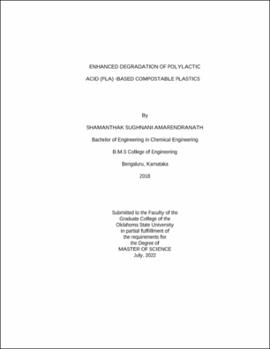| dc.contributor.advisor | Bellmer, Danielle | |
| dc.contributor.author | Amarendranath, Shamanthak Sughnani | |
| dc.date.accessioned | 2023-04-12T19:38:25Z | |
| dc.date.available | 2023-04-12T19:38:25Z | |
| dc.date.issued | 2022-07 | |
| dc.identifier.uri | https://hdl.handle.net/11244/337351 | |
| dc.description.abstract | Plastics are utilized extensively because of their array of functional properties, but plastic pollution has become a global environmental problem. These concerns have spurred the development of numerous compostable plastics. However, many commercial composters don’t want to handle them because their rate of degradation is slower than other typical compost substrates. As a result, most compostable plastics still end up in landfills, where they do not disintegrate. | |
| dc.description.abstract | The overall goal of the project was to develop some pretreatment process to increase the rate of disintegration of compostable plastic. The pretreatment could be applied to compostable plastics at a local level before being taken to a regional commercial compost facility; and hopefully, the pretreated plastics would then be a welcome addition to the commercial compost facility. This study was focused on Polylactic acid (PLA) based compostable plastic because it is the most commonly used. Both biotic and abiotic factors were evaluated to determine their effect on the rate of degradation of compostable plastic. Abiotic pretreatments included soaking the plastic in basic solution, acidic solution, heating the plastic in 75o water, and steam pretreatment. Biotic pretreatments included the use of a spent mushroom compost waste, commercially available compost starter, and compost material from previous batches as inoculum. ISO 20200:2004 standard methodology was used. Experiments were conducted at two different sizes: 6 L vessels and 250 ml flasks. | |
| dc.description.abstract | Use of inoculum and mature compost increased the rate of mycelial growth in the synthetic waste and use of various pretreatments increased the hydrolysis in PLA coupons, making it easier for microbes to degrade, thereby increasing the rate of disintegration. The PLA coupons disintegrated completely in all the treatments and the control, but at different rates. The best performing treatment was a combination of autoclaved plastic and compost starter, which took about 19 days to complete, while the control took about 46 days. Overall, all the treatments were significantly better than control, except mushroom spent waste. | |
| dc.description.abstract | Colorimetric analysis was performed on periodically sampled coupons. A general trend was observed in all the samples, irrespective of the treatment. SEM imaging revealed different surface changes that occurred during the compost process. | |
| dc.format | application/pdf | |
| dc.language | en_US | |
| dc.rights | Copyright is held by the author who has granted the Oklahoma State University Library the non-exclusive right to share this material in its institutional repository. Contact Digital Library Services at lib-dls@okstate.edu or 405-744-9161 for the permission policy on the use, reproduction or distribution of this material. | |
| dc.title | Enhanced degradation of polylactic acid (pla) -based compostable plastics | |
| dc.contributor.committeeMember | Frazier, Scott | |
| dc.contributor.committeeMember | Ramanathan, Ranjith | |
| osu.filename | Amarendranath_okstate_0664M_17773.pdf | |
| osu.accesstype | Open Access | |
| dc.type.genre | Thesis | |
| dc.type.material | Text | |
| dc.subject.keywords | compostable | |
| dc.subject.keywords | degradation | |
| dc.subject.keywords | inoculum | |
| dc.subject.keywords | Polylactic acid | |
| dc.subject.keywords | pretreatment | |
| dc.subject.keywords | spent mushroom | |
| dc.subject.keywords | SEM | |
| dc.subject.keywords | scanning electron microscopy | |
| thesis.degree.discipline | Biosystems Engineering | |
| thesis.degree.grantor | Oklahoma State University | |
